- Share full article
Advertisement
Supported by

Europe’s Juice Mission Launches to Jupiter and Its Moons
The spacecraft has embarked on an eight-year journey to the solar system’s largest planet, focusing on moons that could offer clues in the search for extraterrestrial life.

By Jonathan O’Callaghan
Jupiter, king of the solar system, will be getting a new robotic visitor.
The Jupiter Icy Moons Explorer, or Juice, launched on Friday morning from the Guiana Space Center in Kourou, French Guiana, on the northeastern coast of South America. The original launch, scheduled for Thursday, was delayed after lightning was detected in the vicinity of the launch site.
On Friday the weather improved and the spacecraft, aboard an Ariane 5 rocket, lifted off flawlessly. A half-hour later, Juice separated from the rocket’s second stage and embarked on its long journey.
Jupiter, the largest planet orbiting the sun, is fascinating unto itself, but its massive moons are the ultimate prize. Some of them are hunks of icy rock that may hide life-harboring oceans beneath their surfaces. Juice, from the European Space Agency or ESA, aims to closely study three of Jupiter’s satellites: Callisto, Europa and Ganymede.
“This is one of the most exciting missions we have ever flown in the solar system, by far the most complex” said Josef Aschbacher, the head of ESA.
Weighing in at six tons, the European spacecraft carries 10 advanced scientific instruments to study the moons and capture images. Jupiter is not the mission’s primary target. Instead, it aims to probe Ganymede, the largest moon in the solar system, and two other moons, Europa and Callisto.
But reaching Jupiter will take Juice more than eight years, with a series of swings or gravitational assists past Venus, Mars and Earth to give the spacecraft the push it will need to enter Jupiter’s orbit in July 2031.
When Juice at last reaches Jupiter, it will repeatedly fly past the three moons on a looping orbit, staying outside the giant planet’s dangerous radiation belts as it gathers data. In total, 35 flybys are planned as the spacecraft searches for magnetic signals and other evidence to confirm the presence and size of oceans sloshing under the moons’ surfaces. It will also track how the exteriors of the moons move in response to Jupiter’s gravitational pull, possibly influenced by the subsurface oceans.
The moon that may be most promising in the search for life is Europa. Astronomers think its ocean is directly in contact with a rocky floor, which could provide food and energy for life as hydrothermal vents burst upward. Juice will perform two flybys of Europa.
The spacecraft will also perform 21 flybys of Callisto, which may also possess a salty ocean but is thought to be less capable of supporting life.
But the Juice mission’s primary objective is the study of Ganymede, a moon so large it is bigger than the planet Mercury. The spacecraft’s path around the Jovian system should allow the spacecraft to be captured into orbit around Ganymede in December 2034 — the first spacecraft to orbit a moon in the outer solar system. Beginning at about 3,100 miles above the surface, the spacecraft’s altitude will gradually be lowered to just over 300 miles in 2035 — and perhaps lower, fuel permitting.
“If we have enough propellant, which means we had a good trip to Jupiter without too many problems, we will reduce the orbit to” an altitude of about 150 miles, said Giuseppe Sarri, the project manager for Juice at ESA.
Orbiting Ganymede will allow scientists to intricately understand the moon’s characteristics. It is the only moon in the solar system known to have its own magnetic field, possibly from a liquid iron core like our own planet’s. “If you’re standing on the surface of Ganymede and you had a compass needle, it will point to the north pole like on Earth,” said Michele Dougherty from Imperial College London, who leads the magnetometer instrument on Juice. “We want to understand why.”
Juice should be able to discern the interior structure of Ganymede, including the size and extent of its ocean. It should even be able to measure the salt content of the ocean resulting from minerals that circulate within, which could provide life with sustenance. “We’re trying to understand where the salts came from,” Dr. Dougherty noted.
Ganymede’s ocean differs significantly from Europa’s, but it may still be habitable.
“For habitability you need liquid water, a heat source and organic materials,” Dr. Dougherty said. “If we confirm or deny those three things, we’ve done what we said we were going to do.”
The mission will end in late 2035 with a crash landing onto Ganymede’s surface, unless a discovery is made during the mission that suggests this might contaminate the moon’s ocean.
What other missions will study Jupiter?
Juice is not the only mission investigating Jupiter and its moons.
Juno, a NASA mission, has orbited Jupiter since 2016. Its focus has been the planet itself rather than its moons, although it has recently completed some close flybys of Europa and Ganymede, and soon will swoop past volcanic Io.
But Juice is also expected to be beaten to Jupiter by another new NASA mission, Europa Clipper, which is launching in October 2024. It is scheduled to arrive at the Jovian system in April 2030, owing to its more powerful launch vehicle, a SpaceX Falcon Heavy rocket. But there is no competition; the two missions are intended to work together.
“There will be two spacecraft at the same time looking at Jupiter and its moons,” Dr. Aschbacher said. “There’s a lot of science to be gained from that.”
The two missions were born in 2008 in response to exciting results from NASA’s Galileo spacecraft , which orbited Jupiter from 1995 to 2003.
“Galileo found this very intriguing magnetic signal that suggested there was a conductive ice layer beneath the shell of Europa,” said Louise Prockter of the Johns Hopkins Applied Physics Laboratory, who is part of the Europa Clipper team.
Scientists now think that was a sign of a global ocean encompassing Europa’s interior.
Observations by the Hubble Space Telescope in 2018 suggest Europa may occasionally spurt its ocean up in plumes through cracks in its icy shell, at least 10 miles thick. This could provide a novel way to directly study the ocean and look for signs of life as Clipper darts over the moon’s surface, sometimes at an altitude as low as about 15 miles.
“We could potentially fly through a plume,” Dr. Prockter said.
The results of both Juice and Clipper will reveal whether to attempt a landing on a moon of Jupiter on a future mission, likely at Europa, to directly look for life in the ocean, something NASA has proposed. Such a mission could be two decades away, but its scientific value is immense. Dr. Aschbacher said Europe was interested in something similar.
“We have discussed a sample return mission from one of the icy moons,” he said, which would bring materials back to Earth for closer study. “What we learn from Juice will be an extremely important input to that.”
For now, the spotlight is Juice’s, the first of a new era of spacecraft specifically designed to hunt oceans on alien worlds. “I can’t wait,” Dr. Dougherty said. “This is the next step.”

Science & Technology
Esa science & technology - juice.
- Show All Missions
- Mission Summary
- Science Objectives
- Science Payload
- Scenario & Operations
- The Jupiter System
- Missions to Jupiter
- News Archive
- Multimedia Gallery
- Publication Archive
- Journal Archive
- Terms & Conditions
JUICE intro
Spacecraft testing.

#8: Successful integration of JUICE's 10.6-metre-long arm
The development of ESA's JUpiter ICy moons Explorer (JUICE) is continuing apace and has hit milestones in recent months: the spacecraft's 10.6-metre-long boom is now attached, many instruments have been integrated, and the mission's high-gain antenna has arrived and undergone rigorous vibration testing.

#7: All panels delivered for JUICE's solar wings
All ten flight model solar panels for ESA's JUICE spacecraft have been delivered to Airbus Defence and Space Netherlands ready to be integrated into solar wings. The solar panels, with a total area of 85 m², are a key element of the mission, providing the necessary power to run the spacecraft and operate the science instruments.

#6: Start of assembly and integration for JUICE
Despite certain operational difficulties caused by the COVID-19 pandemic, the assembly and integration of the flight model for ESA's JUpiter ICy moons Explorer (JUICE) spacecraft has continued with few delays during the first six months of the year.

Jupiter mission takes first images of destination – from Earth

Arianespace and ESA announce Jupiter Icy Moons Explorer launch contract

Review board gives JUICE the all clear

JUICE ground control gets green light to start development of Jupiter operations

Helicopter test for Jupiter icy moons radar
Featured publications, juice definition study report (red book), juice science requirement matrix, juice technical and programmatic review report.
Reference: SRE-PA/2011.003/MNCE. This report summarises the findings of the ESA review on the reformulation of EJSM/Laplace (L class mission candidate of the Cosmic Vision 2015-2025 programme) into the new mission concept named JUICE (JUpiter ICy moon Explorer).
JUICE assessment study report (Yellow Book)
Shorturl portlet, https://sci.esa.int/juice, twitter_juicemission, cosmic vision 2015-2025, elsewhere on esa.int.

JUICE moves into Large Space Simulator
Ultra-cool test of jupiter instrument, juice cast in gold, exploring jupiter, jupiter on 25 february 2017.

Exploring planetary plasma environments from your laptop
Esa euronews: unlocking the secrets of the jupiter's icy moons.

- Electronics
- Helicopters
- Cyber & Security
- Uncrewed Systems
- Aerostructures

JUICE’s journey to Jupiter has begun
The adventure of JUICE, a European Space Agency (ESA) probe, began successfully today when it launched into space. Leonardo is taking part in this mission through the JANUS telescope, built by the Italian Space Agency (ASI) with the contribution of the National Institute of Astrophysics (INAF), the MAJIS spectrometer, a French project developed under a bilateral agreement between ASI and CNES, and the solar panels, the largest ever made for a space application.
With JUICE ( JUpiter ICy moons Explorer) lift-off today, Friday 14 April, at 14:14 at the Kourou European Space Centre in French Guiana onboard an Ariane 5 rocket, the European Space Agency’s ( ESA ) mission to explore Jupiter and its lunar system officially kicked off.
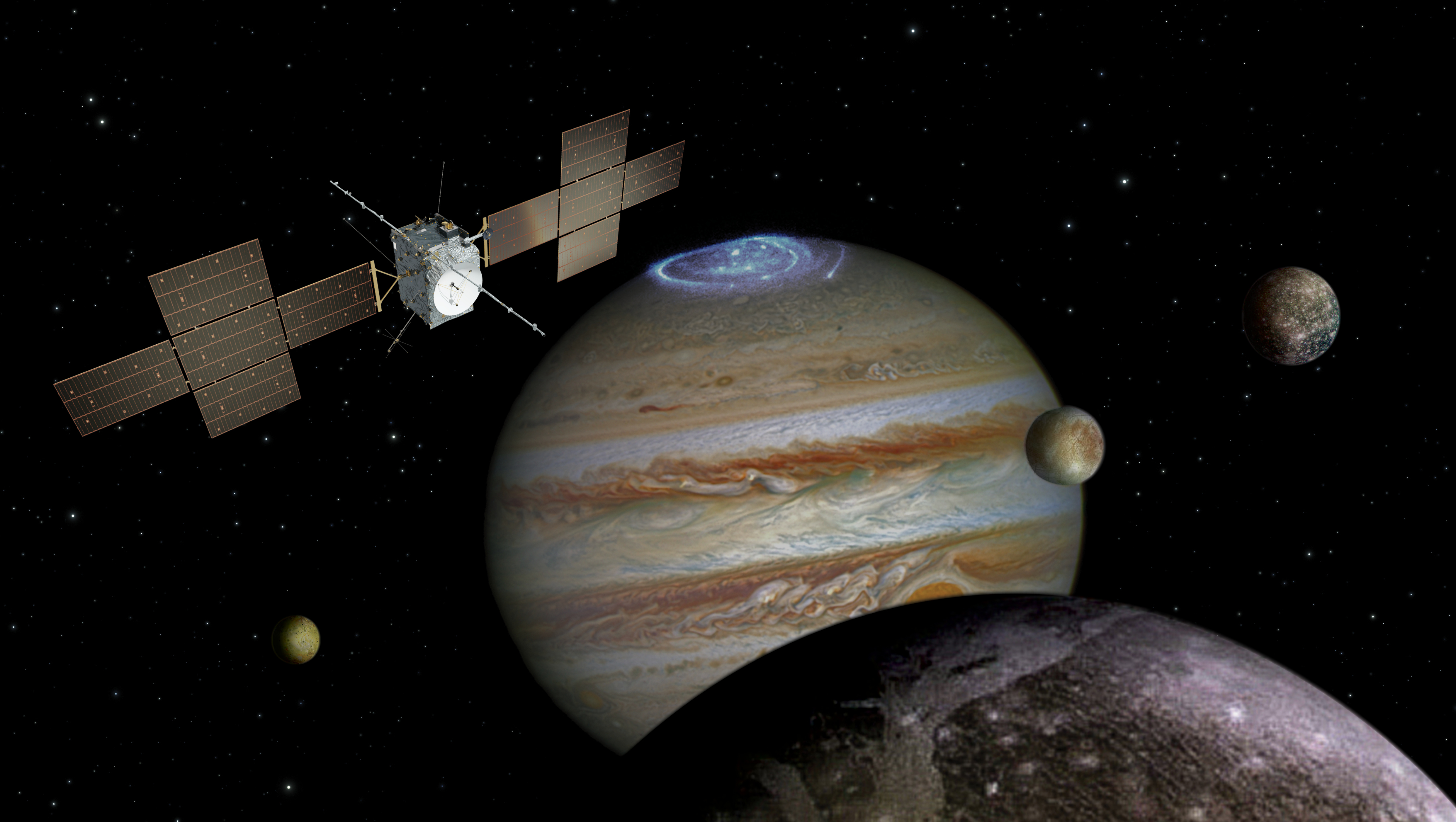
Exploring Jupiter ©ESA - NASA - ATG MediaLab
The probe, which is part of the “ Cosmic Vision ” programme, will travel for eight years to reach the gaseous planet 700 million kilometres away from Earth. It will then remain in orbit around Jupiter and its three moons - Ganymede, Europa and Callisto - so scientists can research planetary formation conditions and life-forming processes.
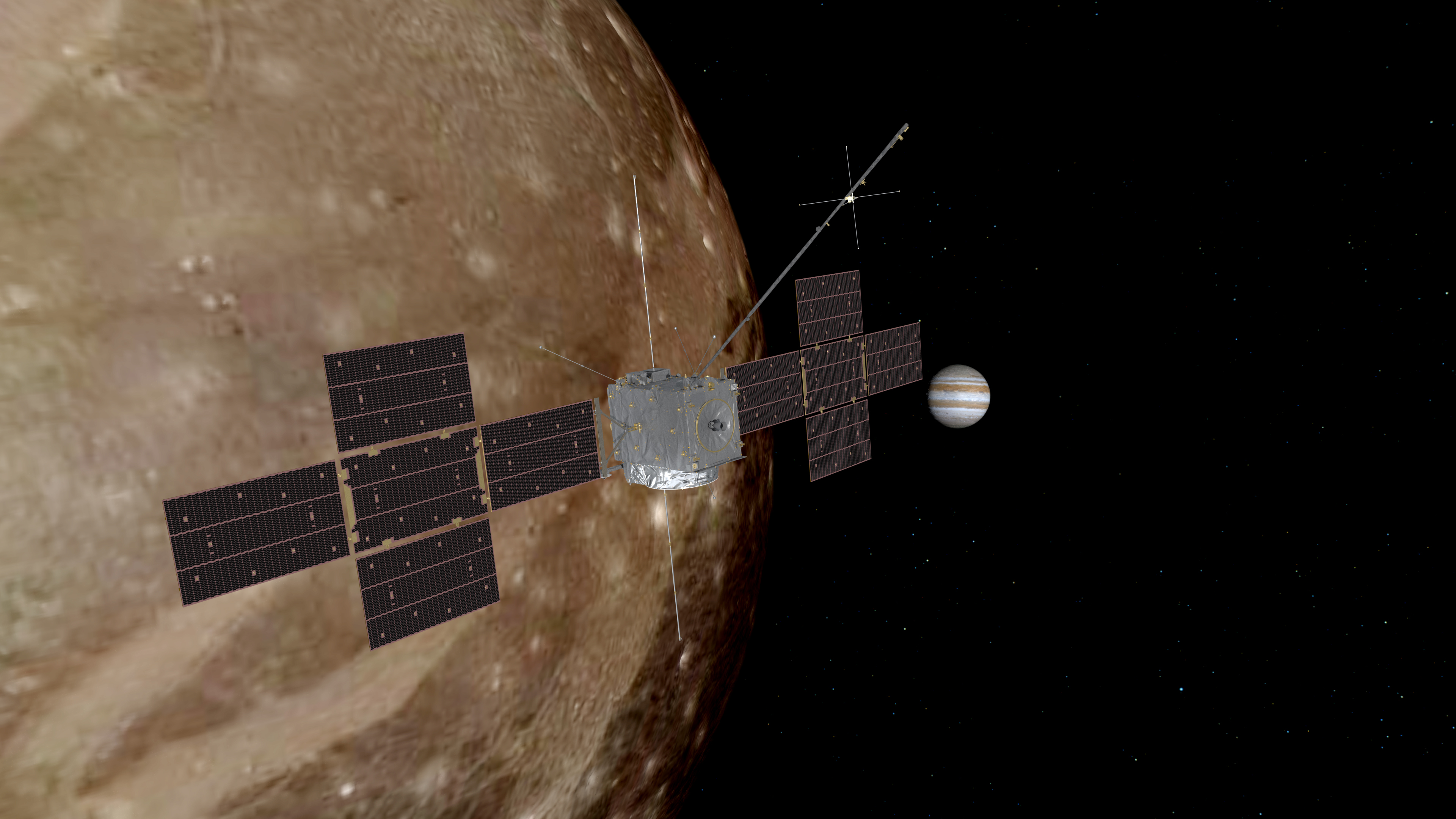
Jupiter and Ganymede ©ESA
With the funding and coordination of the Italian Space Agency (ASI) and the scientific supervision of the National Institute of Astrophysics (INAF), this is an adventure in which the Leonardo. group plays a leading role.
“We are proud to contribute to this European mission to study Jupiter and its moons along with the Italian Space Agency and the academic world. JUICE is setting out on its eight-year journey, during which the largest solar panels ever made for a space mission will supply electricity to the probe and all the onboard instruments. These instruments also include Italian ‘eyes’, a high-resolution JANUS camera and the MAJIS hyperspectral camera, made by Leonardo, which will study a moon much further away than our own,” said Francesco Rizzi , Head of Leonardo’s Space & Optronics business, adding: “It is missions like JUICE that push the frontiers of technology and human knowledge further, and encourage young people to embrace the new challenges of space. ”
Two advanced instruments integrated into the probe - the JANUS telescope and the MAJIS spectrometer - were built at the Leonardo plant in Campi Bisenzio (Florence), while the solar panels (PVA) , with a total area of 85 sq.m, were built at Leonardo’s plant in Nerviano (Milan).

JANUS telescope
This team effort also involves Thales Alenia Space and Telespazio. The former, a joint venture between Thales 67% and Leonardo 33%, participates in the mission having built the RIME (Radar Sounder for Icy Moons Exploration) instrument with the University of Trento and the contribution of several units supplied by NASA/JPL. Thales Alenia Space worked with the University of Rome La Sapienza on the KaT (Ka Translator) of the 3GM instrument.
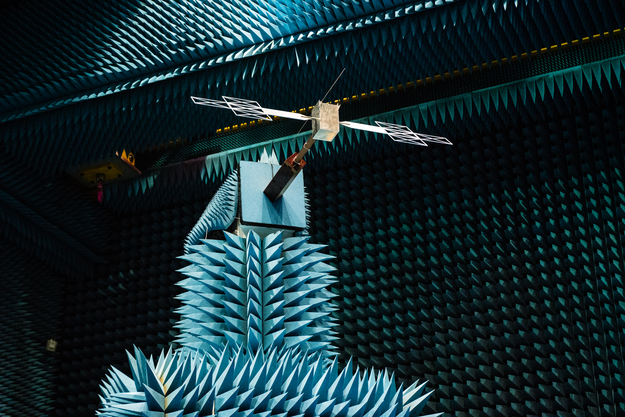
RIME antenna ©Thales Alenia Space
Finally, Telespazio (a joint venture between Leonardo 67% and Thales 33%) provides engineering and operations support to ESA’s European Space Operations Centre (ESOC) through its subsidiary Telespazio Germany .
The probe is scheduled to arrive on Jupiter in July 2031. By 2034, when it goes into orbit around Callisto, it will be the first artificial satellite to orbit another planet’s moon.
For more information :
On Leonardo’s role: https://space.leonardo.com/it/juice
On the launch of JUICE: ESA news
Other news & stories
Receive the latest updates from leonardo.
Register for the News Alert service
2024-05-10T09:09:13Z
cookie_disclaimer:true
page_disclaimer :false

Jupiter Icy Moons Explorer
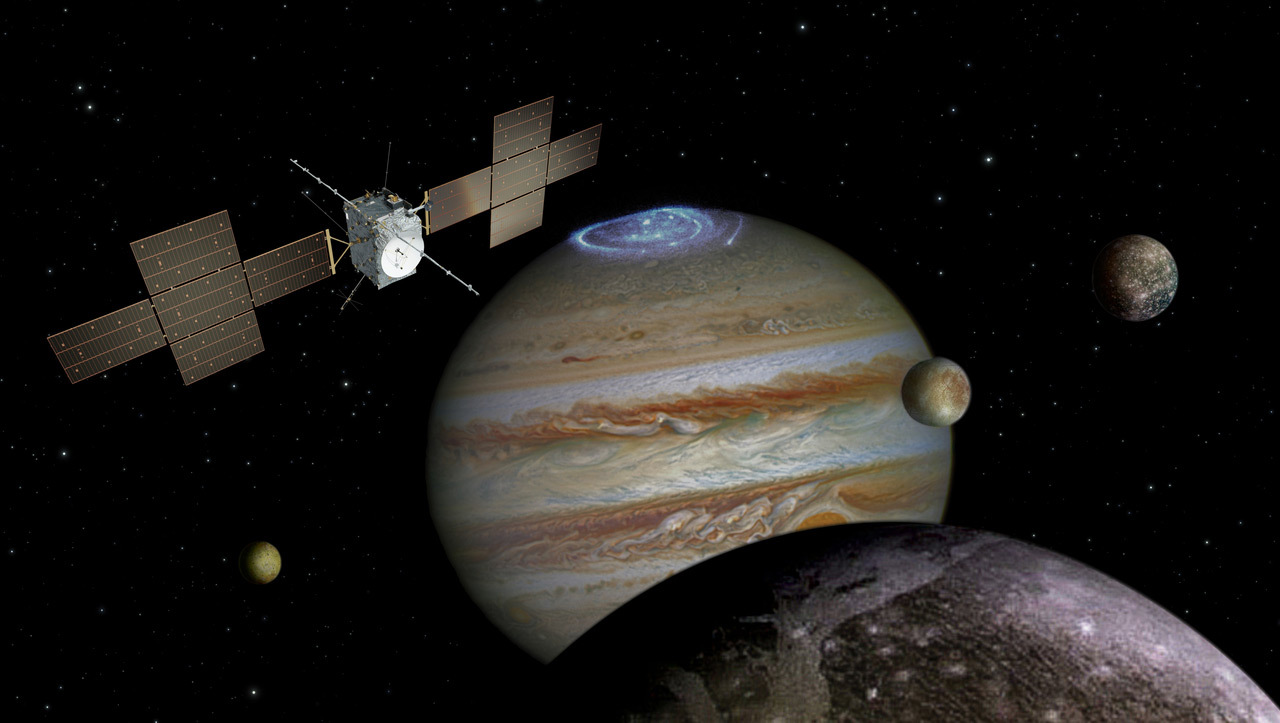
NASA is collaborating with the European Space Agency (ESA) on this ESA-led mission to the Jupiter system.
JUICE Stories
Jupiter’s Great Red Spot
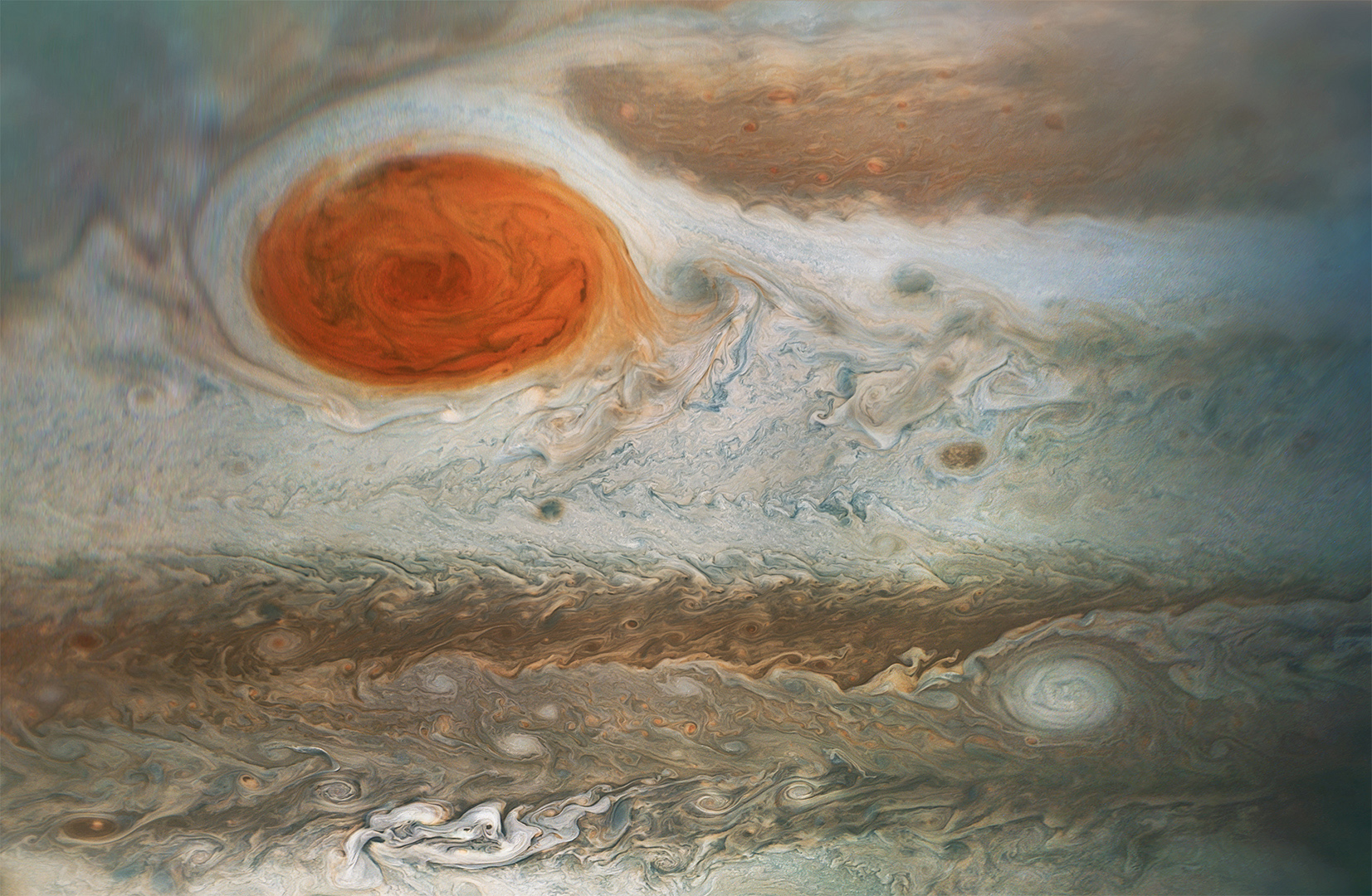
A Moonlit Trio

NASA Selects Students for Europa Clipper Intern Program
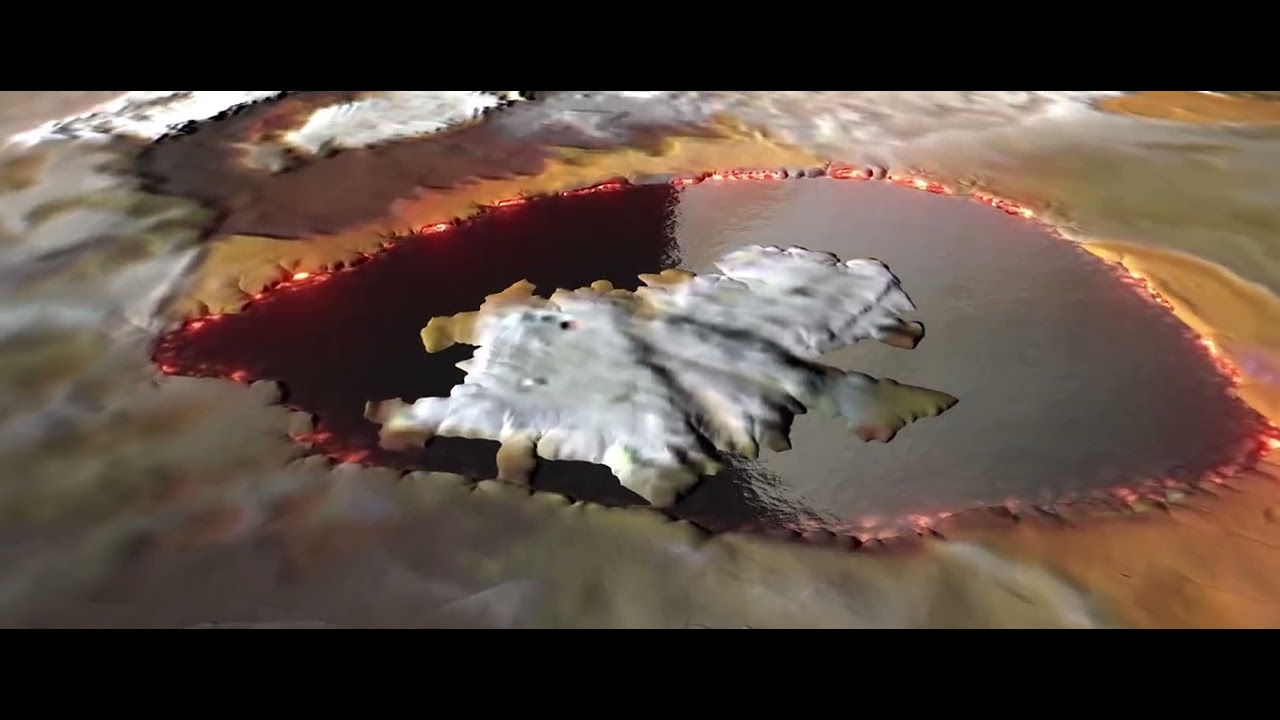
NASA’s Juno Gives Aerial Views of Mountain, Lava Lake on Io
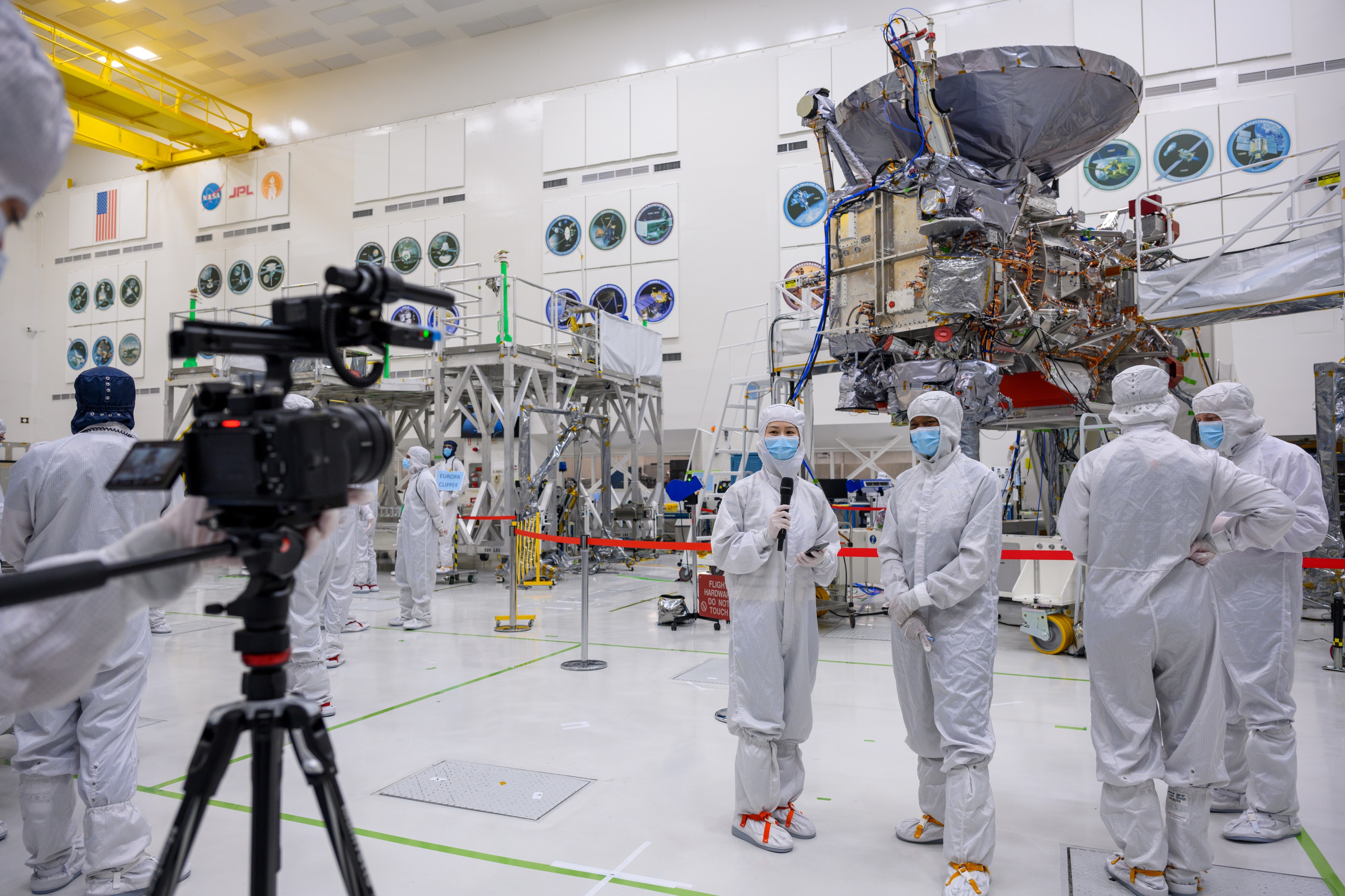
Media Get Close-Up of NASA’s Jupiter-Bound Europa Clipper
Discover More Topics From NASA
James Webb Space Telescope

Perseverance Rover

Parker Solar Probe

- Become A Member
- Gift Membership
- Kids Membership
- Other Ways to Give
- Explore Worlds
- Defend Earth
How We Work
- Education & Public Outreach
- Space Policy & Advocacy
- Science & Technology
- Global Collaboration
Our Results
Learn how our members and community are changing the worlds.
Our citizen-funded spacecraft successfully demonstrated solar sailing for CubeSats.
Space Topics
- Planets & Other Worlds
- Space Missions
- Space Policy
- Planetary Radio
- Space Images
The Planetary Report
The eclipse issue.
Science and splendor under the shadow.
Get Involved
Membership programs for explorers of all ages.
Get updates and weekly tools to learn, share, and advocate for space exploration.
Volunteer as a space advocate.
Support Our Mission
- Renew Membership
- Society Projects
The Planetary Fund
Accelerate progress in our three core enterprises — Explore Worlds, Find Life, and Defend Earth. You can support the entire fund, or designate a core enterprise of your choice.
- Strategic Framework
- News & Press
The Planetary Society
Know the cosmos and our place within it.
Our Mission
Empowering the world's citizens to advance space science and exploration.
- Explore Space
- Take Action
- Member Community
- Account Center
- “Exploration is in our nature.” - Carl Sagan
Planetary Video

Juice's journey to Jupiter
This content is hosted by a third party (youtube.com), which uses marketing cookies. Please accept marketing cookies to watch this video.
ESA's Juice, the Jupiter Icy Moons explorer, will use the gravity of multiple worlds to tweak its trajectory and put it on course for Jupiter, where it will arrive in 2031.
For full functionality of this site it is necessary to enable JavaScript. Here are instructions on how to enable JavaScript in your web browser .
- Accessibility
JUICE – an unprecedented journey to Jupiter

©ESA-CNES-Arianespace/Optique video du CSG/S. Martin

©ESA/CNES/Arianespace/Optique video du CSG/P Baudon

NASA/JPL/Caltech
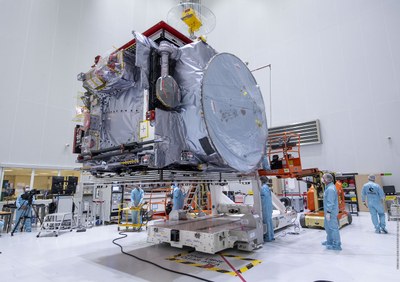
- The JUpiter ICy Moons Explorer (JUICE) spacecraft is scheduled to begin its eight-year journey to Jupiter on 13 April 2023, lifting off from Europe's spaceport in Kourou atop an Ariane 5 launch vehicle.
- After arriving in the Jupiter system in July 2031, JUICE will study the planet and in particular its icy moons from orbit around Jupiter and later around the moon Ganymede.
- Germany is contributing 21 percent to the ESA science programme and thus to financing the costs of developing and constructing the platform, launching and operating JUICE.
- In addition, the German Space Agency at DLR is funding seven of the 10 scientific instruments on JUICE with approximately 100 million euros.
- The DLR Institute of Planetary Research is providing the GALA laser altimeter and making significant contributions to the JANUS camera.
- Focus: Spaceflight, Jupiter, Solar System exploration, search for life
+++ UPDATE: On 14 April 2023 at 14:14 CEST, the Ariane 5 rocket with the JUICE space probe on board was successfully launched from the European spaceport in Kourou. At 15:04 CEST, the spacecraft's signal was aquired by ESA's European Space Operations Centre (ESOC) in Darmstadt, and at 15:33 the solar panels were deployed. JUICE is now on its way to Jupiter. +++
Is there life beyond Earth – perhaps even in the Solar System? This fundamental question continues to motivate the scientific community worldwide. On 13 April 2023, a spacecraft will set off from Europe's spaceport in Kourou, French Guiana, on a long research journey to address this and many other questions. A journey like no other – the European Space Agency 's JUpiter ICy Moons Explorer (JUICE) mission will spend eight years making its way to the largest planet in the Solar System, where it will take a close look at its mysterious icy moons.
In the process JUICE will achieve many firsts. JUICE will be the first spacecraft to use an extremely close – only 750 kilometres away – flyby of the Moon, and 36 hours later of Earth to gain momentum, the first to change orbit from around another planet to one of its moons and the first to orbit a moon other than Earth's. The GAnymede Laser Altimeter (GALA) is the first instrument of its kind to be used in the outer Solar System to scan the surface in three dimensions and thus determine the topography and shape of these moons.
Germany is also part of this exciting journey. The German Space Agency at the German Aerospace Center (Deutsches Zentrum für Luft- und Raumfahrt; DLR), based in Bonn, is supporting JUICE by making the largest single contribution of any ESA member state – 21 percent – to the mission. These funds are part of the financing of the spacecraft, the launch with an Ariane 5 launcher and the mission operations. In addition, approximately 100 million euros will go towards German contributions to seven of a total of 10 scientific instruments on the spacecraft. The DLR Institute of Planetary Research in Berlin is involved in two of these instruments – the GALA laser altimeter was created under DLR's leadership and DLR was part of the Italian-led consortium for the JANUS camera.
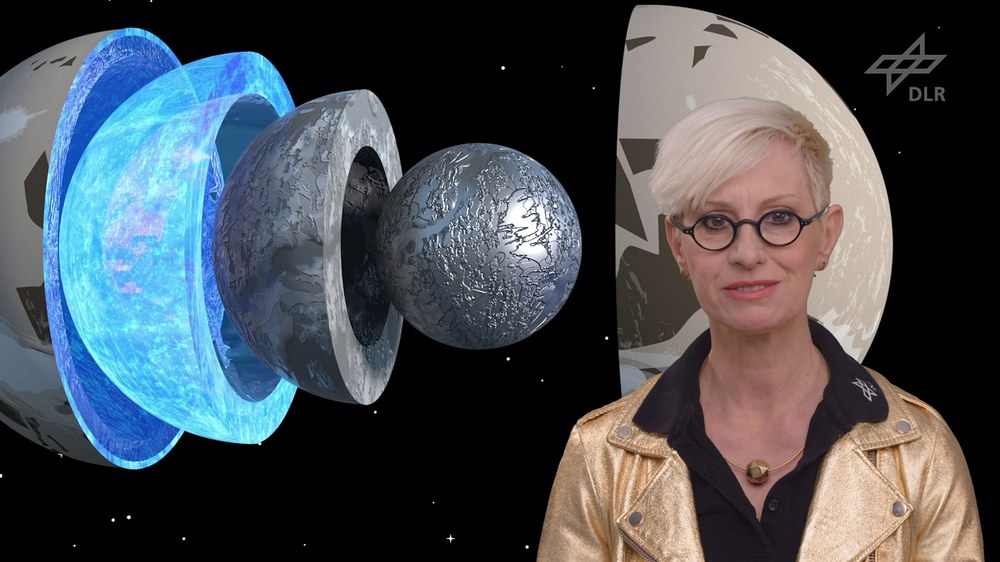
Video: Journey to Jupiter - JUICE and Germany's contribution
Your consent to the storage of data ('cookies') is required for the playback of this video on Youtube.com . You can view and change your current data storage settings at any time under privacy .
"The JUICE mission is the result of successful collaborations at national and European level. After a flight through the Solar System, the DLR instrument GALA on board the JUICE spacecraft will create an elevation model of Jupiter's icy moon Ganymede. The laser altimeter will be used to measure the deformation of Ganymede's ice crust over a period of months. From the amount of deformation, we will be able to determine whether there is an ocean of liquid water beneath the ice crust and how thick the crust is," explains Anke Kaysser-Pyzalla, Chair of the DLR Executive Board. "And what would such a mission be without a camera, so that we on Earth can take part in it? Key components of the JUICE camera hardware were developed and built at the DLR Institute of Planetary Research in Berlin. The JANUS camera system from our Italian partners will provide us on Earth with high-resolution images of the surfaces of the icy moons Ganymede, Callisto and Europa from a few hundred kilometres away."
"ESA's largest interplanetary mission to date is setting off for the biggest planet in the Solar System. JUICE will observe and measure Jupiter and its three large icy moons – Ganymede, Callisto and Europa – in flyby and from orbit using cameras, spectrometers, radar and lasers. Two important instruments were developed and built under German leadership. German institutions are playing a decisive role in another five," says Walther Pelzer, DLR Executive Board member and Director General of the German Space Agency at DLR.
In addition to GALA, a second instrument on board was developed and built in Germany – the Submillimetre Wave Instrument (SWI) of the Max Planck Institute for Solar System Research in Göttingen. This will study the middle atmosphere of Jupiter as well as the extremely thin atmospheres and the surfaces of the 'Galilean moons' Ganymede, Europa and Callisto. For the Italian instrument JANUS (Jovis, Amorum ac Natorum Undique Scrutator), which will primarily observe geological structures of the icy moons partly in high resolution, key parts of the camera system were developed and built by the DLR Institute of Planetary Research.
In addition, the German Space Agency at DLR is funding contributions to the Particle Environment Package (PEP) particle spectrometer, the Jupiter Magnetometer (J-MAG), the Radar for Icy Moons Exploration (RIME) instrument and the instrument for radiosounding the Jupiter atmosphere (3GM) from the National Space Programme.
A traveller like no other
For a special journey, you also need a special 'vehicle'. The JUICE mission's spacecraft has to fulfil complex tasks on its way to the first planet of the outer Solar System. The distance alone presents three challenges. First, the collected data takes 30 to 50 minutes to get back to Earth and new commands take just as long to arrive at the probe. Secondly, the gas giant is 778 million kilometres away from the Sun. Accordingly, it is cold and dark out there. But since the probe also passes Venus, which is close to the Sun, on its way, it must withstand temperature fluctuations of +250 and -230 degrees Celsius on its journey. An elaborate thermal control system consisting of active and passive components, including a new type of Multi-Layer Insulation (MLI), will keep the internal temperature stable. And thirdly, the Sun's light is extremely weak at Jupiter – 25 times weaker than on Earth. Two solar arrays, each with five panels, cover a huge area of 85 square metres and deliver approximately 700 to 900 watts of electrical power. The batteries on board allow the spacecraft to endure eclipses lasting up to five hours. Once JUICE has arrived at Jupiter, the strongest radiation field in the Solar System is 'lurking' in front of and, above all, behind the gas giant.
The instruments also have to be designed to remain functional despite the harsh radiation environment. Close to Jupiter, particles such as protons, electrons and ions from the solar wind and from the volcanic ejections from the moon Io are captured by the planets magnetic field: "The magnetic field accelerates these particles, turning them into small, charged projectiles that will constantly bombard our GALA laser altimeter. To protect the particularly sensitive components of the instrument from this extremely strong radiation, a very special design has been developed. This is the first time such an instrument has been used in the outer Solar System," explains Heike Rauer, Head of the DLR Institute of Planetary Research and she adds: "JUICE is really breaking new scientific ground and will generate data sets with its measurements that will make completely new scientific statements possible and that will complement the results of other missions such as NASA's Europa Clipper perfectly."
An itinerary unlike any other
"To reach the Jupiter system safely and on schedule, the spacecraft is taking a very special travel route. Like on any long trip, JUICE will head for various waypoints to 'fill up' with kinetic energy. After its launch into an orbit around the Sun, the spacecraft will first perform a flyby of Earth and the Moon in August 2024 and gain momentum. This momentum will catapult JUICE to Earth's neighbouring planet, Venus, where it will again significantly increase its speed with the next flyby in August 2025. After that, it will return to Earth twice more, in September 2026 and January 2029. JUICE will then have gained so much momentum through two more close fly-bys of our home planet that the spacecraft will finally reach Jupiter in July 2031. Jupiter orbits just over 600 million kilometres away from the Sun," says Christian Chlebek, JUICE Project Manager at the German Space Agency at DLR, explaining the complex flight manoeuvres of the JUICE mission. Once it arrives at Jupiter, the spacecraft will enter an orbit around the gas giant and make a total of 35 close flybys of the icy moons from July 2031 to November 2034.
After that, things will get exciting again in December 2034. For the first time ever, a spacecraft will change from orbiting another planet to orbiting one of its moons. When JUICE reaches the moon Ganymede, it will also be the first spacecraft ever to orbit a moon other than Earth's natural satellite. In the final part of this journey, DLR's GALA instrument will primarily scan this moon's ice shell for evidence of a subsurface ocean, before JUICE impacts the moon's surface at the end of the mission.
Jupiter and its icy moons
Jupiter was created when the other planets and moons of the Solar System formed after the Sun about 4.5 billion years ago. Gravity pulled swirling gas and dust together to form this giant gas planet, whose diameter of 138,000 kilometres is more than 10 times that of Earth. Jupiter absorbed most of the mass left over after the Sun's formation and ended up with more than twice as much material as all the other bodies in the Solar System combined. In fact, Jupiter has the same components as a star, but it did not become massive enough to become one.
The moons Ganymede, Callisto and Europa, also referred to as the 'Galilean moons' because of their discoverer, are suspected to harbour oceans of water beneath their icy surfaces. This is the element that makes Earth so unique, and it is considered a fundamental prerequisite for life.
Jupiter and its icy moons are not only a significant part of the Solar System but can also help scientists to learn more about the environment around other stars. Thousands of extrasolar planets (exoplanets) have already been discovered. Many of these distant worlds are gas giants like Jupiter. They are too far away to send spacecraft to explore them, but by studying Jupiter, conclusions can be drawn about what these worlds might look like.
Related article
- From Europe to Jupiter via Kourou
Martin Fleischmann
Elisabeth mittelbach, christian chlebek, prof. heike rauer.
What's next for Europe's JUICE mission? Here's what to expect on its long journey to Jupiter
JUICE's journey to Jupiter includes fly-bys of Venus and Earth.
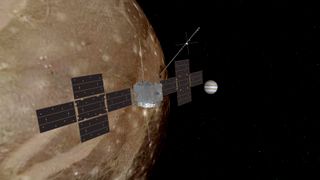
The European Space Agency's (ESA) flagship mission to Jupiter and its icy moons is underway.
But after the successful launch of the JUICE (Jupiter Icy Moons Explorer) spacecraft, what's next for the 1.6 billion euro ($1.77 billion) mission to Jupiter ?
After blasting off into the sky above Europe's spaceport in French Guiana, JUICE now embarks on an eight-year journey that will see it perform fly-bys of Venus and Earth to gain gravity assists that will accelerate it to an encounter with Jupiter in 2031.
But the long journey does not mean that mission scientists will get to put their feet up for eight years. In fact, their work is just beginning.
Related: JUICE: A complete guide to Jupiter's icy moon exploring mission
"It would be nice to forget about it for eight years, but we'll be kept pretty busy planning and replanning," said Randy Gladstone, of the South-west Research Institute in San Antonio, Texas, in an interview with Space.com. Gladstone is the Principal Investigator on JUICE's Ultraviolet Spectrograph (UVS), which is one of NASA's contributions to the JUICE project.
JUICE will return to Earth in August 2024 for a fly-by and gravity assist that will then send it in-system to a rendezvous and another gravity assist at Venus in August 2025. Two more gravity assists with Earth will take place in September 2026 and January 2029, the latter one taking advantage of the dance of the planets and sending JUICE on its way at high speed towards Jupiter.
Get the Space.com Newsletter
Breaking space news, the latest updates on rocket launches, skywatching events and more!

While all this is happening, mission scientists have to learn about how the spacecraft and their instruments work. Although the instruments have been checked out in the laboratories where they were built on Earth , their performance for real in space can create complications.
Learning how the instruments work will be "the first thing to do," said Gladstone. On the spacecraft, the various instruments may begin to impact each other. For example, one instrument next to another might warm up more than its neighbor prefers, affecting the other instruments' functionality, while in the micro-gravity of space the whole spacecraft relaxes leading to small changes in alignment.
To calibrate everything, the instrument teams will use carefully chosen target stars that have very stable and well-known properties. In particular, Gladstone's team will compare the known spectra of the stars with what UVS observes, proceeding to fine-tune the instrument until the observations match the spectra on file.
Some of the calibration of the various instruments will also take place during the fly-bys of Earth and Venus, although testing is limited within two astronomical units of the sun (twice the distance of Earth from the sun , a little bit beyond Mars ' orbit). While in the inner solar system , JUICE will shield its instruments from the sun by using its antenna dish like a parasol. Were the instruments exposed to the bright sun by accident, they could be damaged beyond repair, and so pointing the instruments while close to the sun is prohibited.
"At Venus [the sun] is too hot for us to even operate, but the Earth fly-bys later will be very valuable for calibration and getting ready for Jupiter," said Gladstone.
After its final fly-by of Earth, JUICE will be slingshot on a trajectory towards Jupiter. By this time it will have been overtaken by NASA's Europa Clipper mission, which launches in October 2024 and arrives at Jupiter in April 2030, one year ahead of JUICE.
JUICE won't simply be a bystander while Europa Clipper is in action at Jupiter, where it will possibly join NASA's Juno spacecraft that has been in orbit around Jupiter since 2016, assuming it is still functioning. JUICE will be able to provide early warning for both Europa Clipper and Juno if there is a powerful and potentially harmful solar flare directed at Jupiter.
A year before Jupiter orbit insertion (JOI), "we'll ramp up the team to start making observations," said Gladstone. "They won't all be of Jupiter, but they'll be similar to what we will be doing at Jupiter, so we'll spend a lot of time practicing with the instruments, and planning. There's a lot of stuff we can do, but the planning is the big thing."
Coordinating which instruments will be doing what and when during the 35 fly-bys of three of Jupiter's moons (two fly-bys of Europa , 12 of Ganymede and 21 of Callisto ) will require much negotiation between the various instrument teams as well as those responsible for the spacecraft's fuel and power supplies.
"We're all pretty agreeable, but it's still a lot of work to sort out what we're going to do second-by-second for the five years that we're there at Jupiter," said Gladstone. "But we'll figure out the best way to get the best science for each fly-by."
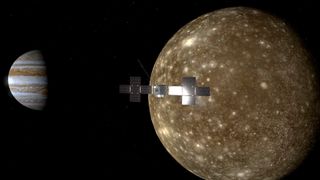
From Gladstone's point of view, the UVS is concerned with mapping ultraviolet emissions. It does this by passing ultraviolet light through a slit, after which it hits a diffraction grating that spreads out the light into its various ultraviolet wavelengths — a spectrum.
"Most matter interacts really strongly with ultraviolet light, and [UVS] is very sensitive to tiny amounts of gases, which is sort of what Jupiter's moons have for atmospheres," said Gladstone.
These tenuous atmospheres — referred to as 'exospheres' — cling to the moons, sputtered off their surface by micrometeorite impacts. They can be observed either directly through their ultraviolet emissions when atoms and molecules are excited by collisions with charged particles that fizz around Jupiter's powerful magnetosphere, or indirectly by watching a moon's exosphere absorb some of the light of a star or the sun during an occultation. The wavelength absorbed gives away the identity of the atom or molecule doing the absorbing.
Meanwhile, ultraviolet sunlight reflected by the moons can give away details about their surfaces.
"UVS will tell us a lot about the surface composition and structure," said Gladstone. "We know the surfaces are icy, but there's a lot of other materials down there besides the ice."
UVS will also be able to study the ultraviolet auroras that flicker around the magnetic poles of Jupiter. These auroras have previously been observed by the Hubble Space Telescope , the James Webb Space Telescope and by Juno. However, Hubble and James Webb cannot keep a constant eye on the auroras, and Juno spins on its axis to maintain its stability, meaning that its instruments cannot linger on the auroras long enough to see the fainter ones.
"With JUICE we'll be able to look at those fainter auroras too," said Gladstone.
— Why will it take Europe's JUICE spacecraft 8 years to get to Jupiter?
— ESA's Jupiter mission JUICE is not 'strong enough' to orbit potentially life-harboring Europa. Here's why
— How the risk of biological contamination could complicate the fate of Europe's Jupiter mission
The planning and practicing that will take place over the next eight years will set the stage for the epic of discovery that will follow, as JUICE provides an unprecedented tour of the Jovian system. Gladstone can't wait to get started.
"There's a lot of great stuff to learn," he said. "With all the variety JUICE is going to see and do, it's going to be exciting once it gets there."
Follow Keith Cooper on Twitter @21stCenturySETI . Follow us on Twitter @Spacedotcom and on Facebook .
Join our Space Forums to keep talking space on the latest missions, night sky and more! And if you have a news tip, correction or comment, let us know at: [email protected].

Keith Cooper is a freelance science journalist and editor in the United Kingdom, and has a degree in physics and astrophysics from the University of Manchester. He's the author of "The Contact Paradox: Challenging Our Assumptions in the Search for Extraterrestrial Intelligence" (Bloomsbury Sigma, 2020) and has written articles on astronomy, space, physics and astrobiology for a multitude of magazines and websites.
China's Chang'e 6 mission to moon's far side enters lunar orbit (video)
China launches Chang'e 6 sample-return mission to moon's far side (video)
Axiom Space eyes the moon while continuing to dream big in Earth orbit
Most Popular
- 2 This diamond exoplanet lost its atmosphere — then it grew another
- 3 Solar eclipse 2024: Live updates
- 4 China just sent a secret mini-rover to the far side of the moon on its Chang'e 6 sample-return probe
- 5 Sun explodes in a flurry of powerful solar flares from hyperactive sunspots (video)
Juice Journey VA
Hours updated over 3 months ago

Location & Hours
Suggest an edit
1231 Mall Dr
Richmond, VA 23235
You Might Also Consider

Coalesce Coffee Co
Coalesce Coffee Co. is a mobile coffee bar serving speciality espresso beverages, apple cider, hot chocolate, pastries and more. Coalesce serves at various locations throughout Richmond including festivals, weddings, community… read more
in Food Trucks, Coffee & Tea

DQ Grill & Chill
3.0 miles away from Juice Journey VA
DQ Mother's Day Cake
in Patisserie/cake Shop, Custom Cakes, Desserts
Amenities and More
Powered by Health Department Intelligence
Ask the Community
Ask a question
Yelp users haven’t asked any questions yet about Juice Journey VA .
Recommended Reviews
- 1 star rating Not good
- 2 star rating Could’ve been better
- 3 star rating OK
- 4 star rating Good
- 5 star rating Great
Select your rating
Overall rating

So happy I found this place! Great owners, clean, fresh, great menu and the bowl was incredible!!!

Found this little gem looking for a healthy smoothie place after my BURN work! The soups, wraps, and smoothie are the most delicious! (I could eat the cauliflower curry soup everyday!!) #rvahiddengems #JuiceJourneyVA #Plantbased #Veganoptions #bestfoodrva #supportlocal #eatclean

I'm from NY an my brother from this spot the food was great , the drinks were wonderful I had the ocean blue it was out of this world I'm going been every day until I go back to NY and one of the owners is from NY
Great local place for delicious, healthy lunch or snack! stumbled upon it earlier today. Family owned business, everyone was very helpful and friendly. I had the tropical blast smoothie...delicious! I recommend this place! A bit hard to find as it's tucked off the main road in an office park but GPS will get you there.
Outstanding, delicious and healthy. Service was great and the owners engaging. Nice decor. We will be back!!
3 other reviews that are not currently recommended

Lemaire Restaurant
April K. said "First, let's start with the bad- we were told by the hostess that they were super busy today but if we went to the back that we would find seating. We obviously were able to see that they were busy, but don't tell customers to go…" read more
in New American

Torchy’s Tacos
0.4 miles away from Juice Journey VA
John G. said "We went to this place having no expectations - just an open mind. We had read about the huge following this place has. We opted to sit at the bar. It looked inviting. The bartender (Lisa) was SUPER nice and helpful for our first…" read more
in Tacos, Mexican, Breakfast & Brunch
People Also Viewed

Soul n’ Vinegar

Green Apple

Ms. Bee’s Juice Bar

North End Juice

Urban Farmhouse

United Latino Market

The Beet Box

Good Life Juices

Gold Lion Community Cafe
Best of Richmond
Things to do in Richmond
Other Places Nearby
Find more Breakfast Brunch Spots near Juice Journey VA
Find more Juice Bars & Smoothies near Juice Journey VA
Find more Soup Spots near Juice Journey VA
Browse Nearby
Restaurants
Things to Do
Thrift Stores
Dining in Richmond
Search for Reservations
Book a Table in Richmond
NASA Black Hole Visualization Takes Viewers Beyond the Brink
- Released Monday, May 6, 2024
- Produced by:
- Scott Wiessinger
- Written by:
- Francis Reddy
- Visualizations by:
- Jeremy Schnittman
In this flight toward a supermassive black hole, labels highlight many of the fascinating features produced by the effects of general relativity along the way. This supercomputer visualization tracks a camera as it approaches, briefly orbits, and then crosses the event horizon — the point of no return — of a supersized black hole similar in mass to the one at the center of our galaxy. Credit: NASA's Goddard Space Flight Center/J. Schnittman and B. PowellMusic: “Tidal Force,” Thomas Daniel Bellingham [PRS], Universal Production Music“Memories” from Digital Juice“Path Finder,” Eric Jacobsen [TONO] and Lorenzo Castellarin [BMI], Universal Production MusicWatch this video on the NASA Goddard YouTube channel.Complete transcript available.
- 14576_BHPlunge_Explainer_4k.mp4 [1.5 GB]
- 14576_BHPlunge_Explainer_4kYouTube.mp4 [3.0 GB]
- 14576_BHPlunge_Explainer_1080.mp4 [319.5 MB]
- 14576_BHPlunge_Explainer_ProRes_3840x2160_2997.mov [12.8 GB]
- 14576_BHPlunge_Explainer_Captions.en_US.srt [2.5 KB]
- 14576_BHPlunge_Explainer_Captions.en_US.vtt [2.4 KB]
- 14576_BHPlunge_Explain_Still.jpg (3840x2160) [1.2 MB]
- 14576_PageThumbnail.jpg (3840x2160) [1.2 MB]
- 14576_PageThumbnail_searchweb.png (320x180) [85.0 KB]
- 14576_PageThumbnail_thm.png (80x40) [9.6 KB]
Complete transcript available.
- The outer edge of the accretion disk extends to a radius of about 97 million miles (156 million kilometers), comparable to the distance between Earth and the Sun.
- The inner edge of the accretion disk starts at a radius of around 23 million miles (38 million kilometers), about 25% of the Earth-Sun distance.
- The radius of the photon ring is 15.5 million miles (25 million kilometers).
- The event horizon radius is about 7.8 million miles (12.5 million kilometers).
- Spaghettification occurs around 79,500 miles (128,000 kilometers) from the singularity, the center of the black hole.
This version is encoded to play as a 360 VR movie. It follows the plunge of a simulated camera into a non-rotating supermassive black hole. The object's mass is 4.3 million Suns, equivalent to the black hole lying at the center of our Milky Way galaxy. The orange structure surrounding the black hole represents the hot, glowing gas of its accretion disk, where infalling matter collects and slowly spirals inward. Interior to the disk is a thin set of photon rings, which are images of the disk produced by light that has orbited the black hole one or more times before reaching the camera. The camera completes almost two orbits before hitting the event horizon. During the journey, a variety of effects caused by the gravitationally warped space-time around the black hole and the camera's speed become increasingly apparent. Images of the disk and the background sky morph, duplicate, and even form mirror images. Structures in the direction of travel, at the center of the simulation, brighten greatly as speed increases. At 42 seconds, the camera crosses the event horizon, traveling ever closer to the speed of light. Due to the camera’s speed, the entire sky appears to shift progressively forward, shrinking before our eyes. After entering the event horizon, the camera would be destroyed by tidal forces 12.8 seconds later, then in microseconds rush to the singularity, a point in the black hole's center where the laws of physics as we know them no longer apply.Credit: NASA's Goddard Space Flight Center/J. Schnittman and B. PowellMusic: “Tidal Force,” Thomas Daniel Bellingham [PRS], Universal Production MusicWatch this video on the NASA Goddard YouTube channel.Complete transcript available.
- 14576_BHPlunge_360_FINAL_1080.mp4 [169.2 MB]
- 14576_BHPlunge_360_FINAL_4k.mp4 [636.4 MB]
- 14576_BHPlunge_360_FINAL_8k.mp4 [1.2 GB]
- 14576_BHPlunge_360_Captions.en_US.srt [211 bytes]
- 14576_BHPlunge_360_Captions.en_US.vtt [211 bytes]
- 14576_BHPlunge_360_Still.jpg (3840x2160) [906.4 KB]
Camera plunge, equidistant rectangular projection. This all-sky movie follows the plunge of a simulated camera into a non-rotating supermassive black hole. The object's mass is 4.3 million Suns, equivalent to the black hole lying at the center of our Milky Way galaxy. The orange structure surrounding the black hole represents the hot, glowing gas of its accretion disk, where infalling matter collects and slowly spirals inward. Interior to the disk is a thin set of photon rings, which are images of the disk produced by light that has orbited the black hole one or more times before reaching the camera. The camera completes almost two orbits before hitting the event horizon. During the journey, a variety of effects caused by the gravitationally warped space-time around the black hole and the camera's speed become increasingly apparent. Images of the disk and the background sky morph, duplicate, and even form mirror images. Structures in the direction of travel, at the center of the simulation, brighten greatly as speed increases. At 42 seconds, the camera crosses the event horizon, traveling ever closer to the speed of light. Due to the camera’s speed, the entire sky appears to shift progressively forward, shrinking before our eyes. After entering the event horizon, the camera would be destroyed by tidal forces 12.8 seconds later, then in microseconds rush to the singularity, a point in the black hole's center where the laws of physics as we know them no longer apply. Credit: NASA's Goddard Space Flight Center/J. Schnittman and B. Powell
- 14576_BH_Plunge_Rectilinear_8192x4096_60.mp4 [699.3 MB]
- 14576_BH_Plunge_Rectilinear_4096x2048_60.mp4 [349.7 MB]
- 14576_BH_Plunge_Rectilinear_2160x1080_30.mp4 [105.3 MB]
- 14576_BH_Plunge_Rectilinear_ProRes_8192x4096_60.mov [23.9 GB]
- Plunge_Rect [256.0 KB]
- Plunge_Rectilinear_Still_03528.jpg (8192x4096) [1.2 MB]
Credit: NASA's Goddard Space Flight Center/J. Schnittman and B. Powell
Camera plunge, Mollweide equal-area projection. This all-sky movie follows the plunge of a simulated camera into a non-rotating supermassive black hole. The object's mass is 4.3 million Suns, equivalent to the black hole lying at the center of our Milky Way galaxy. The orange structure surrounding the black hole represents the hot, glowing gas of its accretion disk, where infalling matter collects and slowly spirals inward. Interior to the disk is a thin set of photon rings, which are images of the disk produced by light that has orbited the black hole one or more times before reaching the camera. The camera completes almost two orbits before hitting the event horizon. During the journey, a variety of effects caused by the gravitationally warped space-time around the black hole and the camera's speed become increasingly apparent. Images of the disk and the background sky morph, duplicate, and even form mirror images. Structures in the direction of travel, at the center of the simulation, brighten greatly as speed increases. At 42 seconds, the camera crosses the event horizon, traveling ever closer to the speed of light. Due to the camera’s speed, the entire sky appears to shift progressively forward, shrinking before our eyes. After entering the event horizon, the camera would be destroyed by tidal forces 12.8 seconds later, then in microseconds rush to the singularity, a point in the black hole's center where the laws of physics as we know them no longer apply.Credit: NASA's Goddard Space Flight Center/J. Schnittman and B. Powell
- 14576_BH_Plunge_Mollweide_8192x4096_60.mp4 [699.0 MB]
- 14576_BH_Plunge_Mollweide_2160x1080_30.mp4 [105.5 MB]
- 14576_BH_Plunge_Mollweide_4096x2048_60.mp4 [349.7 MB]
- 14576_BH_Plunge_Mollweide_ProRes_8192x4096_60.mov [24.8 GB]
- Plunge_Moll [256.0 KB]
- Plunge_Mollweide_Still_02190.jpg (8192x4096) [3.5 MB]
This sequence shows a zoom into the plunging camera’s direction of travel to reveal the detailed structure of the photon rings. Each band is a distorted image of the gas disk layered between the background sky. Successive bands are thinner, produced by photons that have taken an additional trip around the black hole before reaching the camera. Due to the camera’s speed, which approaches 99.9% that of light toward the end, the entire sky appears to shift progressively forward, seemingly shrinking before our eyes. The field of view is 10 degrees across, about the width of a fist held at arm’s length. Credit: NASA's Goddard Space Flight Center/J. Schnittman and B. Powell
- 14576_BH_Plunge_Zoom2b_1080.mp4 [74.0 MB]
- 14576_BH_Plunge_Zoom_ProRes_3840x2160_60.mov [4.3 GB]
- 14576_BH_Plunge_Zoom2b_4k60.mp4 [241.0 MB]
- 14576_BH_Plunge_Zoom2b_ProRes_3840x2160_60.mov [4.1 GB]
- Plunge_Zoom [256.0 KB]
- Plunge_Zoom_Still_03607.jpg (3840x2160) [1.4 MB]
Plunge camera track. This movie tracks the position and orientation of the falling camera relative to the black hole. The inner circle represents the event horizon, the dashed circle represents the photon ring, which forms at the edge of the event horizon's shadow (twice the event horizon's size), and the dotted line shows the camera's path. A red line represents the plane of the accretion disk surrounding the black hole. At about 15 seconds, the image zooms in to follow the camera as it makes almost two loops around the black hole. At 42 seconds, the camera slips past the event horizon and arcs to the black hole's center.Credit: NASA's Goddard Space Flight Center/J. SchnittmanVisual description: On a black background, a white cartoon camera approaches a broken red line interrupted by a large dashed white circle at its center. Inside the dashed circle is a smaller white circle with a solid line. The camera, trailing a dotted line as it travels, spirals into the central white circle.
- 14576_BH_Plunge_Inset_900x480_60.mp4 [4.9 MB]
- 14576_BH_Plunge_Inset_ProRes_900x480_60.mov [153.1 MB]
- Plunge_Camera [256.0 KB]
- Plunge_Inset_Still_03170.jpg (900x480) [26.7 KB]
Visual description: On a black background, a white cartoon camera approaches a broken red line interrupted by a large dashed white circle at its center. Inside the dashed circle is a smaller white circle with a solid line. The camera, trailing a dotted line as it travels, spirals into the central white circle.
Plunge clock comparison. This movie tracks the local time of the falling camera, the time as experienced by a faraway observer (coordinate time), and the maximum blueshift observed. This is the factor by which the frequency of light in the direction of travel is increased. At 42 seconds, coordinate time reads all 9s, indicating that the camera has crossed the event horizon and external time is infinite. The blueshift continues to climb, exceeding 43 by the end, which indicates motion exceeding 99.9% light speed.Credit: NASA's Goddard Space Flight Center/J. SchnittmanVisual description: A box on a white background contains three lines of text. The top line reads "local time," the second line reads "coord time," and the third reads "max blueshift." As the video plays, these times increase and diverge as described above.
- 14576_BH_Plunge_Times_900x480_60.mp4 [15.8 MB]
- 14576_BH_Plunge_Times_ProRes_900x480_60.mov [154.5 MB]
- Plunge_Times [256.0 KB]
- Plunge_Times_Still_03900.jpg (900x480) [24.4 KB]
Visual description: A box on a white background contains three lines of text. The top line reads "local time," the second line reads "coord time," and the third reads "max blueshift." As the video plays, these times increase and diverge as described above.
In this flight toward a supermassive black hole, labels highlight many of the fascinating features produced by the effects of general relativity along the way. This supercomputer visualization tracks a camera as it approaches, falls toward, briefly orbits, and escapes a supersized black hole similar in mass to the one at the center of our galaxy. Credit: NASA's Goddard Space Flight Center/J. Schnittman and B. PowellMusic: "Beautiful Awesome,” David Husband and James William Banbury [PRS], Universal Production Music“Awakening Yearning,” David Ashok Ramani and Jonathan Elias [ASCAP], Universal Production Music“Dawning,” Lorenzo Castellarin [BMI], Universal Production MusicWatch this video on the NASA Goddard YouTube channel.Complete transcript available.
- 14576_BHFlyBy_Explainer_1080.mp4 [294.7 MB]
- 14576_BHFlyBy_Explainer_4k.mp4 [1.4 GB]
- 14576_BHFlyBy_Explainer_4kYouTube.mp4 [2.8 GB]
- 14576_BHFlyBy_Explainer_ProRes_3840x2160_2997.mov [12.9 GB]
- 14576_BHFlyBy_Explainer_Captions.en_US.srt [2.4 KB]
- 14576_BHFlyBy_Explainer_Captions.en_US.vtt [2.3 KB]
- 14576_BHFlyBy_Explain_Still.jpg (3840x2160) [1.1 MB]
This version is encoded to play as a 360 VR movie. It follows the trajectory of a simulated camera approaching and looping around a non-rotating supermassive black hole. The object's mass is 4.3 million Suns, equivalent to the black hole lying at the center of our Milky Way galaxy. The orange structure surrounding the black hole represents the hot, glowing gas of its accretion disk, where infalling matter collects and slowly spirals inward. Interior to the disk is a thin set of photon rings, which are images of the disk produced by light that has orbited the black hole one or more times before reaching the camera. The camera completes two orbits before escaping back out to safety. During the journey, a variety of effects caused by the gravitationally warped space-time around the black hole and the camera's speed become increasingly apparent. Images of the disk and the background sky morph, duplicate, and even form mirror images. Structures in the direction of travel, at the center of the simulation, brighten greatly as speed increases. At 46 seconds, the camera makes its closest approach to the event horizon, reaching maximum velocity at 60% the speed of light.Credit: NASA's Goddard Space Flight Center/J. Schnittman and B. PowellMusic: "Beautiful Awesome,” David Husband and James William Banbury [PRS], Universal Production MusicWatch this video on the NASA Goddard YouTube channel.Complete transcript available.
- 14576_BHFlyBy_360_FINAL_1080.mp4 [188.8 MB]
- 14576_BHFlyBy_360_FINAL_4k.mp4 [699.8 MB]
- 14576_BHFlyBy_360_FINAL_8k.mp4 [1.4 GB]
- 14576_BHFlyBy_360VR_FINAL_8k.mp4 [1.4 GB]
- 14576_BHFlyBy_360VR_FINAL_4k.mp4 [699.8 MB]
- 14576_BHFlyBy_360VR_FINAL_1080.mp4 [188.9 MB]
- 14576_BHFlyBy_360_Captions.en_US.srt [213 bytes]
- 14576_BHFlyBy_360_Captions.en_US.vtt [213 bytes]
- 14576_BHFlyBy_360_Still.jpg (3840x2160) [1.1 MB]
Camera flyby, equidistant rectangular projection. This all-sky movie follows the trajectory of a simulated camera approaching and orbiting a non-rotating supermassive black hole. The object's mass is 4.3 million Suns, equivalent to the black hole lying at the center of our Milky Way galaxy. The orange structure surrounding the black hole represents the hot, glowing gas of its accretion disk, where infalling matter collects and slowly spirals inward. Interior to the disk is a thin set of photon rings, which are images of the disk produced by light that has orbited the black hole one or more times before reaching the camera. The camera completes two orbits before escaping back out to safety. During the journey, a variety of effects caused by the gravitationally warped space-time around the black hole and the camera's speed become increasingly apparent. Images of the disk and the background sky morph, duplicate, and even form mirror images. Structures in the direction of travel, at the center of the simulation, brighten greatly as speed increases. At 46 seconds, the camera makes its closest approach to the event horizon, reaching maximum velocity at 60% the speed of light. Credit: NASA's Goddard Space Flight Center/J. Schnittman and B. Powell
- 14576_BH_FlyBy_Rectilinear_2160x1080_30.mp4 [118.4 MB]
- 14576_BH_FlyBy_Rectilinear_4096x2048_60.mp4 [395.0 MB]
- 14576_BH_FlyBy_Rectilinear_8192x4096_60.mp4 [789.8 MB]
- 14576_BH_FlyBy_Rectilinear_ProRes_8192x4096_60.mov [33.3 GB]
- FlyBy_Rect [256.0 KB]
- FlyBy_Rectilinear_01787.jpg (8192x4096) [3.9 MB]
Camera flyby, Mollweide equal-area projection. This all-sky movie follows the trajectory of a simulated camera approaching and orbiting a non-rotating supermassive black hole. The object's mass is 4.3 million Suns, equivalent to the black hole lying at the center of our Milky Way galaxy. The orange structure surrounding the black hole represents the hot, glowing gas of its accretion disk, where infalling matter collects and slowly spirals inward. Interior to the disk is a thin set of photon rings, which are images of the disk produced by light that has orbited the black hole one or more times before reaching the camera. The camera completes two orbits before escaping back out to safety. During the journey, a variety of effects caused by the gravitationally warped space-time around the black hole and the camera's speed become increasingly apparent. Images of the disk and the background sky morph, duplicate, and even form mirror images. Structures in the direction of travel, at the center of the simulation, brighten greatly as speed increases. At 46 seconds, the camera makes its closest approach to the event horizon, reaching maximum velocity at 60% the speed of light. Credit: NASA's Goddard Space Flight Center/J. Schnittman and B. Powell
- 14576_BH_FlyBy_Mollweide_ProRes_8192x4096_60.mov [35.8 GB]
- 14576_BH_FlyBy_Mollweide_4096x2048_60.mp4 [395.1 MB]
- 14576_BH_FlyBy_Mollweide_8192x4096_60.mp4 [789.8 MB]
- FlyBy_Moll [256.0 KB]
- FlyBy_Mollweide_Still_01830.jpg (8192x4096) [3.6 MB]
This sequence shows a zoom into the camera’s direction of travel as it loops around the black hole to reveal the detailed structure of the photon rings. Each band is a distorted image of the gas disk layered between the background sky. Successive bands are thinner, produced by photons that have taken an additional trip around the black hole before reaching the camera. The field of view is 10 degrees across, about the width of a fist held at arm’s length. Credit: NASA's Goddard Space Flight Center/J. Schnittman and B. Powell
- 14576_BH_FlyBy_Zoom2_1920x1080_30.mp4 [78.6 MB]
- 14576_BH_FlyBy_Zoom2_3840x2160_60.mp4 [196.6 MB]
- 14576_BH_FlyBy_Zoom2_ProRes_3840x2160_60.mov [3.0 GB]
- FlyBy_Zoom [128.0 KB]
- FlyBy_Zoom_Still_01650.jpg (3840x2160) [914.1 KB]
Flyby camera track. This movie tracks the position and orientation of the falling camera relative to the black hole. The inner circle represents the event horizon, the dashed circle represents the photon ring, which forms at the edge of the event horizon's shadow (twice the event horizon's size), and At about 15 seconds, the image zooms in to follow the camera as it makes two loops around the black hole. At 46 seconds, the image zooms out as the camera escapes. Credit: NASA's Goddard Space Flight Center/J. SchnittmanVisual description: On a black background, a white cartoon camera approaches a broken red line interrupted by a large dashed white circle at its center. Inside the dashed circle is a smaller white circle with a solid line. The camera, trailing a dotted line as it travels, loops twice around the dashed circle.
- 14576_BH_FlyBy_Inset_900x480_60.mp4 [8.6 MB]
- 14576_BH_FlyBy_Inset_ProRes_900x480_60.mov [143.7 MB]
- FlyBy_Camera [256.0 KB]
- FlyBy_Inset_Still_03126.jpg (900x480) [26.5 KB]
Visual description: On a black background, a white cartoon camera approaches a broken red line interrupted by a large dashed white circle at its center. Inside the dashed circle is a smaller white circle with a solid line. The camera, trailing a dotted line as it travels, loops twice around the dashed circle.
Flyby clock comparison. This movie tracks the local time of the falling camera, the time as experienced by a faraway observer (coordinate time), and the maximum blueshift observed. This is the factor by which the frequency of light in the direction of travel is increased. As the video plays, these times increase and diverge, and by the end, local time lags coordinate time by 36 minutes. At 46 seconds, the blueshift reaches 2.34 as the camera's motion peaks at 60% the speed of light.Credit: NASA's Goddard Space Flight Center/J. SchnittmanVisual description: A box on a white background contains three lines of text. The top line reads "local time," the second line reads "coord time," and the third reads "max blueshift."
- 14576_BH_FlyBy_Timess_900x480_60.mp4 [22.3 MB]
- 14576_BH_FlyBy_Times_ProRes_900x480_60.mov [172.6 MB]
- FlyBy_Times [256.0 KB]
- FlyBy_Times_Still_04360.jpg (900x480) [23.6 KB]
Visual description: A box on a white background contains three lines of text. The top line reads "local time," the second line reads "coord time," and the third reads "max blueshift."
For More Information
See NASA.gov
- Astrophysics
- Supercomputer
- Supermassive Black Hole
- Visualization
Please give credit for this item to: NASA's Goddard Space Flight Center. However, individual items should be credited as indicated above.
- Scott Wiessinger (KBR Wyle Services, LLC)
Science writer
- Francis Reddy (University of Maryland College Park)
- Jeremy Schnittman (NASA/GSFC)
- Brian Powell (NASA/GSFC)
- Ernie Wright (USRA)
Release date
This page was originally published on Monday, May 6, 2024. This page was last updated on Monday, May 6, 2024 at 4:04 PM EDT.
- Astrophysics Features
- Astrophysics Simulations
- Astrophysics Visualizations
- Black Hole Week
- Narrated Movies
Beyond the Brink: Tracking a Simulated Plunge into a Black Hole
Nasa visualization probes the doubly warped world of binary black holes, black hole accretion disk visualization, you may also like..., no results., an error occurred. please reload this page and try again..
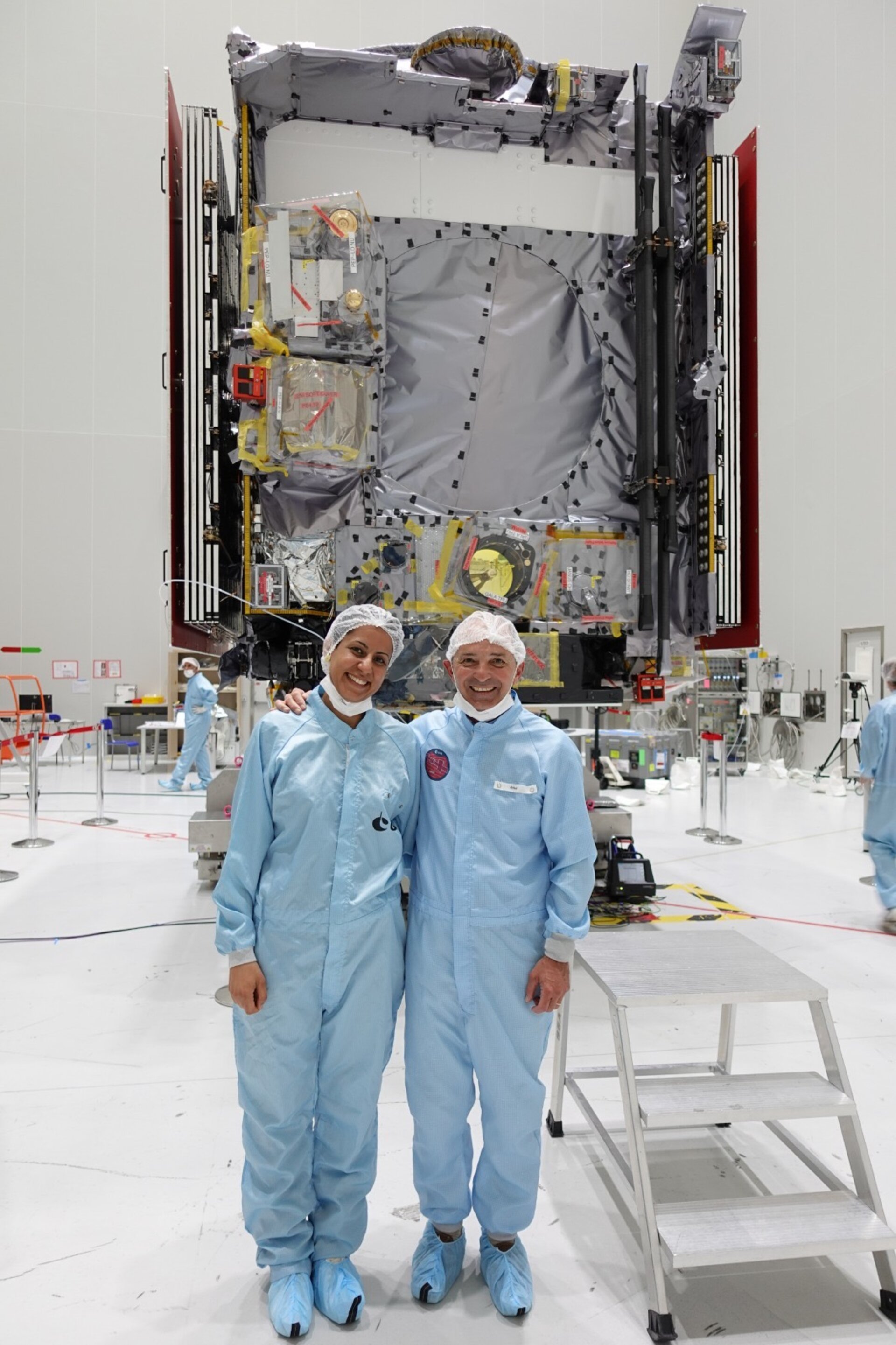
Wafaa and Ared with Juice explorer
- HI-RES JPG [367.71 kB]
Thank you for liking
You have already liked this page, you can only like it once!
Wafaa Tabibi deputy head for the Upper Part Combined Operations Manager (left), and Ared Schnorhk, Assembly Integration and Testing and Launcher Interface Manager posing in front of ESA's Juice satellite. The Jupiter Icy Moons Explorer, Juice, will make detailed observations of the giant gas planet and its three large ocean-bearing moons – Ganymede, Callisto and Europa – with a suite of remote sensing, geophysical and in situ instruments. The mission will characterise these moons as both planetary objects and possible habitats, explore Jupiter’s complex environment in depth, and study the wider Jupiter system as an archetype for gas giants across the Universe.
ESA’s latest interplanetary mission, Juice , lifted off on an Ariane 5 rocket from Europe’s Spaceport in French Guiana, at 14:14 CEST on 14 April 2023 to begin its eight-year journey to Jupiter, where it will study in detail the gas giant planet’s three large ocean-bearing moons: Ganymede, Callisto and Europa.
- LICENCE ESA Standard Licence
- Space Transportation
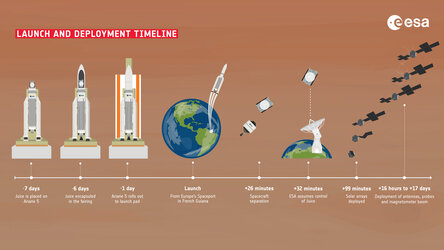
Juice launch and deployment timeline
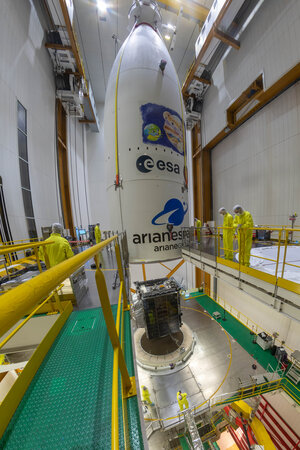
Juice encapsulated in Ariane 5 fairing


COMMENTS
ESA's Jupiter Icy Moons Explorer, Juice, will make detailed observations of the giant gas planet and its three large ocean-bearing moons - Ganymede, Callisto and Europa - with a suite of remote sensing, geophysical and in situ instruments. The mission will characterise these moons as both planetary objects and possible habitats, explore ...
A half-hour later, Juice separated from the rocket's second stage and embarked on its long journey. Jupiter, the largest planet orbiting the sun, is fascinating unto itself, but its massive ...
Watch on. This animation shows the journey of the JUICE spacecraft to Jupiter. The proposed trajectory of JUICE is traced as a white line beginning inside Earth's orbit (shown in blue). By following the trajectory, it is possible to appreciate the gravity-assist strategy—a sequence of flybys of Earth, Venus, Earth, Mars, and again Earth ...
The 24-year-old filmed the moment Juice left Earth and started its long, long journey to Jupiter. You can hear crowds in awe as the rocket hurtles above them into outer space. Article share tools
3 April 2019 ESA's JUpiter ICy moons Explorer, JUICE, has been given the green light for full development after its critical design review was successfully concluded on 4 March. This major milestone marks the beginning of the qualification and production phase, taking this flagship mission one key step closer to starting its long journey to Jupiter in 2022.
With JUICE (JUpiter ICy moons Explorer) lift-off today, Friday 14 April, at 14:14 at the Kourou European Space Centre in French Guiana onboard an Ariane 5 rocket, the European Space Agency's (ESA) mission to explore Jupiter and its lunar system officially kicked off.. Exploring Jupiter ©ESA - NASA - ATG MediaLab. The probe, which is part of the "Cosmic Vision" programme, will travel for ...
NASA/JPL-Caltech/VTAD. Goals. JUICE ( JUpiter ICy moons Explorer) will explore Jupiter and three of its icy moons in depth. Launch. April 14, 2023. Arrival at Jupiter. July 2031. Science Targets. Jupiter, Ganymede, Callisto, Europa.
The Jupiter Icy Moons Explorer (Juice, formerly JUICE) is an interplanetary spacecraft on its way to orbit and study three icy moons of Jupiter: Ganymede, Callisto, and Europa. These planetary-mass moons are planned to be studied because they are thought to have beneath their frozen surfaces significant bodies of liquid water, which would make ...
This animation shows the journey of the JUICE spacecraft to Jupiter. The proposed trajectory of JUICE is traced as a white line beginning inside Earth's orbi...
This animation shows the proposed trajectory of ESA's Jupiter Icy Moons Explore (Juice) mission to Jupiter. Based on a launch in June 2022, the spacecraft wi...
Journey to Jupiter. Juice is the last ESA space science mission to launch on an Ariane 5, in a long legacy dating back to 1999 with the launch of XMM-Newton, which is still in operation today, and most recently, the NASA/ESA/CSA James Webb Space Telescope in 2021. "What a magnificent demonstration of Europe's capacity to dream big and deliver results to match," says Daniel Neuenschwander ...
The journey to Jupiter . During its 8-year journey, JUICE will save on propellent by making four gravity assists taking energy from planets Earth and Venus as well as Earth's moon to put itself on ...
JUICE will journey for eight years through deep space. NASA's Galileo probe took about six years to trek to Jupiter, launching in October 1989 and arriving in orbit in December 1995.
An illustration of JUICE's journey and the gravity assists that will get the spacecraft to the Jovian system. (Image credit: ESA/ADS) Studying Jupiter and three icy ocean moons
Juice's journey to Jupiter. This content is hosted by a third party (youtube.com), which uses marketing cookies. Please accept marketing cookies to watch this video. ESA's Juice, the Jupiter Icy Moons explorer, will use the gravity of multiple worlds to tweak its trajectory and put it on course for Jupiter, where it will arrive in 2031. ...
The JUpiter ICy Moons Explorer (JUICE) spacecraft is scheduled to begin its eight-year journey to Jupiter on 13 April 2023, lifting off from Europe's spaceport in Kourou atop an Ariane 5 launch vehicle. After arriving in the Jupiter system in July 2031, JUICE will study the planet and in particular its icy moons from orbit around Jupiter and ...
ESA's Jupiter Icy Moons Explorer, Juice, is set to embark on an eight-year cruise to Jupiter starting April 2023. The mission will investigate the emergence ...
An illustration of JUICE's journey and the gravity assists that will get the spacecraft to the Jovian system. (Image credit: ESA/ADS) While all this is happening, mission scientists have to learn ...
Yelp users haven't asked any questions yet about Juice Journey VA. Recommended Reviews. Your trust is our top concern, so businesses can't pay to alter or remove their reviews. Learn more about reviews. Username. Location. 0. 0. Choose a star rating on a scale of 1 to 5. 1 star rating. Not good. 2 star rating. Could've been better.
У 2012 році Європейське космічне агентство (ЄКА) в рамках своєї програми Cosmic Vision обрало місію JUICE (Jupiter Icy Moons Explorer) для дослідження трьох із чотирьох галілеєвих супутників Юпітера із можливою ...
Jelly Roll is sharing his joy after accomplishing a huge goal.. The country crooner is currently on a weight loss journey, previously opening up about his health and prior experiences with ...
ESA's Jupiter Icy Moons Explorer is on an eight-year cruise to Jupiter that started in April 2023.On its journey Juice will make a series of flybys of Earth, the Earth-Moon system and Venus to set it on course for its July 2031 rendezvous in the Jovian system.
In this flight toward a supermassive black hole, labels highlight many of the fascinating features produced by the effects of general relativity along the way. This supercomputer visualization tracks a camera as it approaches, briefly orbits, and then crosses the event horizon — the point of no return — of a supersized black hole similar in mass to the one at the center of our ...
The Jupiter Icy Moons Explorer, Juice, will make detailed observations of the giant gas planet and its three large ocean-bearing moons - Ganymede, Callisto and Europa - with a suite of remote sensing, geophysical and in situ instruments. ... at 14:14 CEST on 14 April 2023 to begin its eight-year journey to Jupiter, where it will study in ...